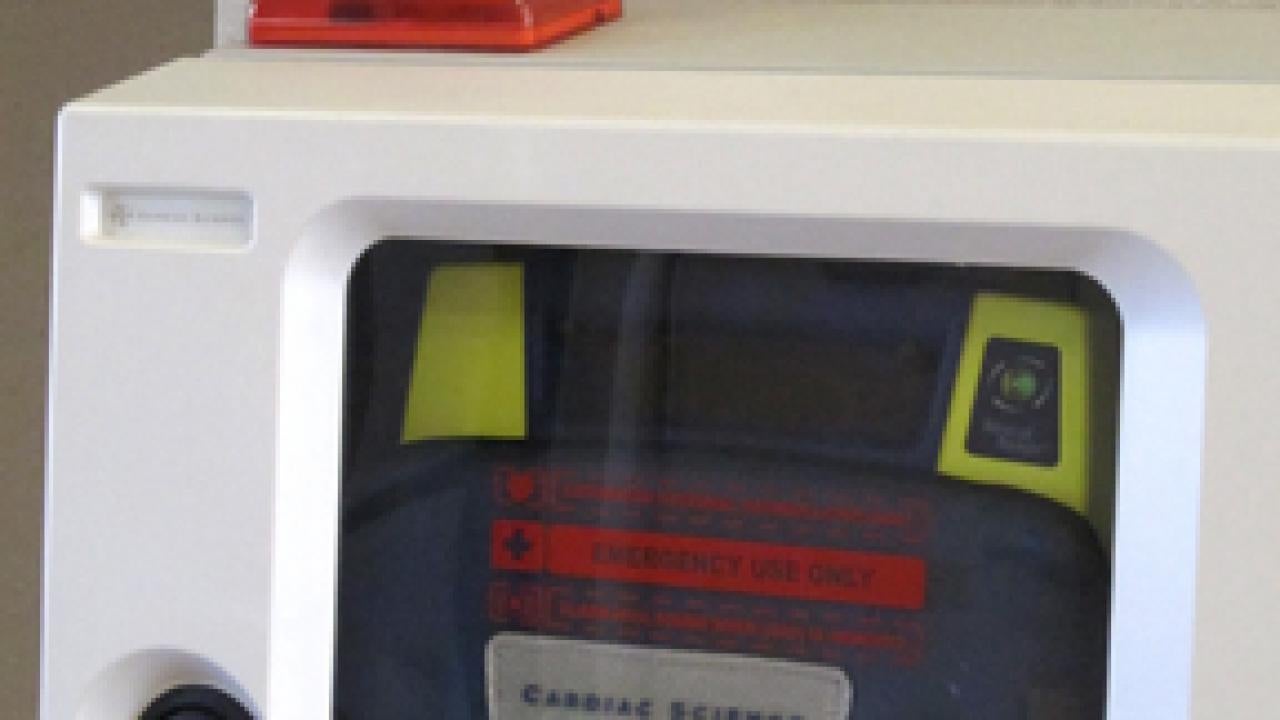No doubt you have seen them hanging on walls in buildings around the campus: AEDs, or automated external defibrillators, portable devices that deliver an electric shock to restore an effective heart rhythm.
They are typically deployed in public places, and designed for use by laymen — but only those who are certified in CPR (cardiopulmonary resuscitation) and in the use of an AED. UC Davis offers this training free to employees. See details below.
On Dec. 22, three trained rescuers — a UC Davis employee and two alumni — put their CPR and AED skills to work in the fitness room at the Activities and Recreation Center, saving Gary Colberg’s life.
See separate stories about the rescue and Colberg's emotional reunion with his rescuers.
“In this emergency at the ARC we saw the positive outcomes that result when calm heads apply proven life-saving skills,” said Nate Trauernicht, assistant fire chief for the recently consolidated campus and city of Davis fire departments.
“It’s not enough to just take CPR once in a lifetime and expect to perform well under pressure. Be prepared to help a loved one or a stranger at a moment’s notice by keeping your CPR certification current and learning how to use an AED.
“The effort that we all put into training results in the best thing possible, the gift of life.”
The defibrillators started popping up around UC Davis in 2006, through the Enhanced Life-Saving Program, run by the Fire Department in collaboration with the Campus Safety Council.
AEDs can be deployed in individual departments, and within buildings where multiple departments choose to go in together for one of the devices. The hosting department or departments must pay for the purchase and installation.
The initial cost ranges from about $1,500 to $2,000. An AED needs a replacement battery about every four years or so, at a cost of about $500, and the sensor pads (attached to the patient) need to be replaced about every two years, or after the pads are used, for about $100.
Also, the hosting department or departments must appoint an AED coordinator, who facilitates AED training for people who work in the building, and who checks the AED monthly to be sure it is in working order.
The Fire Department troubleshoots all reported problems with the units, and maintains the computer software in each of the AEDs.
As of today, the Enhanced Life-Saving Program has deployed nearly 50 AEDs, most of them on the main campus. Locations include the Activities and Recreation Center, Hickey Pool and Rec Pool, Aggie Stadium, the Memorial Union, Freeborn Hall and the Mondavi Center, and Mrak Hall and the dean’s office in the Social Sciences and Humanities Building.
Additional units are in west campus and south campus buildings, and in outlying research centers. Also, the Police Department has put AEDs in 10 patrol cars. (The Fire Department has four AEDs of its own, in four firetrucks.)
More information about the Enhanced Life-Saving Program is available online, or by contacting Meghan Scannell at the Fire Department, (530) 754-9176 or mescannell@ucdavis.edu. The website includes an outline of the basic steps involved in acquiring an AED.
Adult CPR-AED training
Classes in adult CPR-AED are scheduled twice a month through June, with funding from the UC system’s Be Smart About Safety program.
The first classes of the year are scheduled for Jan. 12 and 25 — and space was still available in both as of today (Jan. 7).
Online registration. (Search for “Adult CPR-AED.”) The registration site includes the complete schedule through June.
First aid training
The university at this time is not offering basic first aid classes for employees. If there is sufficient interest, however, officials indicated that they would discuss the possibility of presenting such classes under the auspices of Be Smart About Safety.
Andrew Majewski, Environmental Health and Safety manager, said the America Red Cross has provided basic first aid training directly to departments in the past.
The campus’s Safety Services unit offers wilderness first aid for employees who work in remote locales (more than 30 minutes from the nearest medical center).
Outdoor Adventures, a unit of Campus Recreation, offers training in AED-CPR and basic first aid, as well as wilderness first aid.
More information
American Red Cross Capital Region Chapter
Outdoor Adventures health care classes
Read more
Dave Jones, editor of Dateline UC Davis, and Barbara Brady, director of communications, Administrative and Resource Management, contributed to this report.
Media Resources
Dave Jones, Dateline, 530-752-6556, dljones@ucdavis.edu
